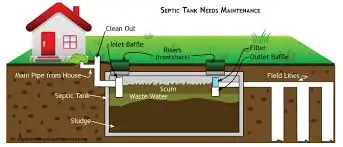What is a septic inspection?
If you use a septic system, you must regularly get your septic tank inspected. There is absolutely no two ways about it. A septic inspection can identify any repairs that your systems need. Spotting minor problems can result in an inexpensive and quick repair. If a small problem goes undetected, over time it can grow into a more complex and expensive repair. A septic inspection can also provide you with a complete status report about your septic system, giving you a clear idea of how much gunk is present in the system and when the tank will need to be pumped out.
So, what is a septic inspection? A septic inspection involves a thorough investigation of the septic tank. It includes a visual inspection, which involves checking the water pressure and ensuring everything is draining properly. A full inspection, on the other hand, is more comprehensive and looks at every aspect of your septic system.
Continue reading to find out what a septic inspection is in greater detail and more.
Call Septic Service Pros 1.855-925-0760 For Service or Request a Quote
What is a septic inspection?
A septic inspection involves a thorough investigation of your septic tank to make sure everything is order. Septic inspections are of two types:
Visual Inspection
When purchasing or selling a property, the home inspector will likely complete a visual septic inspection.
As part of the visual inspection, the home inspector will ask you a few questions, such as:
- What is the age of the house?
- When was the last septic inspection done?
- How often the septic system is pumped?
Apart from asking questions, the inspector will flush every toilet and run copious amounts of water to ensure the water pressure is neither below nor above par. He or she will also check whether everything is properly draining. Lastly, the home inspector will check your drain field to ensure there is absolutely no presence of standing water.
You can give you an idea about the health of your septic system through a visual inspection quickly. But if you want a comprehensive report, you should opt for a full inspection.
Full Inspection
A full septic inspection involves a thorough inspection of your septic system. You should opt for a full inspection once every 3 to 5 years, depending on the size of your septic tank and other things.
The inspector will start a full inspection by removing the septic tank cover and checking the level of water inside it. Inspecting the water level is necessary because that shows whether the wastewater is properly draining or not. Next, the inspector will run all the water in house to check if water is flowing properly from your house to your septic tank and to ensure the level of water within the septic tank does not go up when more water is introduced.
The septic tank inspection might run a dye test, which involves introducing dye into the water which is being drained out to check how much of it enters your septic tank.
Following this, the inspector will order the pumping of your septic tank and check if there is any backflow. A backflow from absorption area means there is some issue with the drain field. The water level flow is checked once more to ensure all aspects of your septic system are in perfect order and there are absolutely no blockages.
Call Septic Service Pros 1.855-925-0760 For Service or Request a Quote
How often should one opt for a septic inspection?
Most experts believe that homeowners should get their septic tank inspected once every 3 to 5 years. The best time for a septic inspection is around the time you get your tank pumped out. In order to keep the tank in good working order, it is important that you get it pumped and inspected regularly.
Most of the times, it is almost impossible to know whether your drainage system is efficiently working or not. Generally, it is only when the septic system starts to crumble, and the signs like foul smell or backflows start manifesting, that homeowners become aware of a potential issue. A septic tank inspection can quickly and easily resolve issues before they snowball into a big — and expensive — problem. With the cost of replacing a tank often being upward of $3,500, it makes a lot of sense to get your system inspected at regular intervals.
How long does a septic tank inspection take?
Generally speaking, a septic tank inspection takes around 45 minutes to 2 hours. That said, a bigger tank may take more time to be inspected. The septic inspector may also take more time than usual if a complicated issue reveals itself during the inspection. Nevertheless, in most cases, a septic tank inspection gets completed in less than 3 hours. To learn more about how long a septic inspection can take read this.
Does the septic need to be pumped for an inspection?
If you are going for a full inspection, the answer is, “Yes.” It is necessary for the septic tank to be pumped before a septic inspection. Pumping the tank gives the inspector a chance to observe your septic tank after it has been emptied out. That is important because water entering into your septic tank from outlet pipe work could indicate toward a problem.
Why is a septic inspection needed?
A septic inspection helps identify any issues that may be plaguing your septic system. This in turn allows you to resolve small problems quickly and cheaply. Otherwise, small issues can turn into serious issues, which can prove very costly to repair. A septic inspection is a health checkup of your septic system, that is, it tells you how healthy your septic system.










